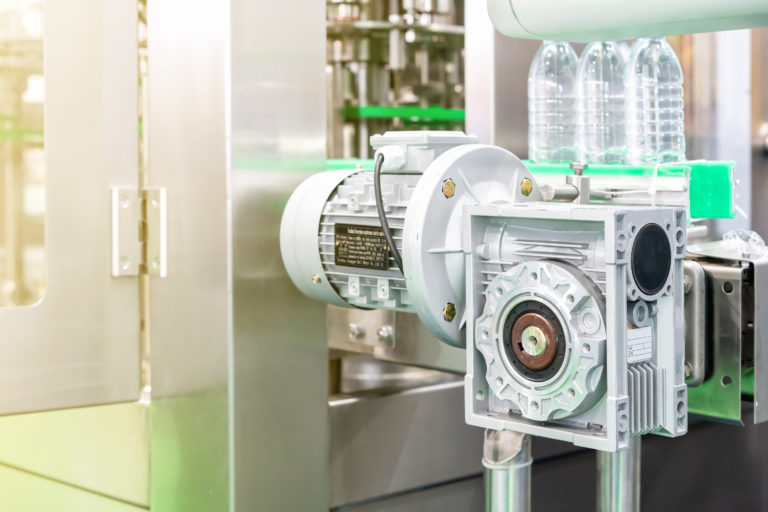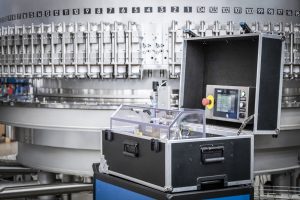Commissioning Motors for Reliable and Efficient Service

close up modern of gearbox and electric motor install at automatic bottle injection machine for constant speed control conveyor. (Image source: AEMT)
Careful installation of motors will help ensure their efficient and reliable operation, minimising the potential for costly downtime or sub-standard operation. It is therefore essential that particular care is taken when installing and starting motors that have been in storage or that have been subject to an off-site repair.
Stored Motors
A motor which has been in storage should first be cleaned to bring it back to the condition it was in when placed in storage. If there are any signs of damage, such as broken cooling fins, they should be investigated to assess whether any internal damage could have occurred and, where necessary, the damage repaired.
In an ideal scenario, motors should be stored in a vibration-free environment; however, this is not always practical. If the motor under inspection may have been subject to vibration, there is a potential for the bearings to have been damaged. Even minimal ambient vibration will cause motor bearings to wear over time and can result in fretting or false brinelling, which can lead to motor failure. Therefore, unless there is complete certainty that the stored motor was not subjected to any vibration, the bearings should be inspected for signs of wear and replaced if necessary.
Bearing lubrication should also be considered when taking a motor from storage. Where the motor uses sealed bearings, if it has been in storage for an extended period of around two years or more, it is highly likely that the grease inside the bearing will have separated and will not work optimally. If the date when the bearing was fitted is unknown, or the motor has been in storage for a long time, then it would be advisable to replace the bearing.
Motors which utilise re-greaseable bearings should be regreased. And if there are any signs of water in the grease purged from the motor, there will likely be rust damage, and the bearings should be replaced.
All stored motors will be subject to some degree of temperature fluctuation, and this will cause the seals to expand and contract, allowing moisture to enter the motor. Where the motor is oil-lubricated, it is, therefore, good practice to change the oil before starting it after a long period of inactivity. To minimise the likelihood that the motor’s windings are contaminated by oil, it is advisable to drain the oil before it is moved from its storage location and then refill it after it has been installed.
If good practice was followed when the motor was put into storage, an insulation resistance (IR) test, which measures the total resistance between any two points separated by electrical insulation, should have been carried out. This test determines how effective the insulation is in resisting the flow of electrical current. Before putting a motor back into service, repeat this test to ensure that any decreases in insulation effectiveness that may have occurred during storage can be addressed.
Repaired Motors
If an AEMT member has repaired the motor, it is likely to have been done following the international repair, overhaul and reclamation of rotating equipment standard, IEC 60034-23:2019, and it is a good idea to check if this has been followed. The standard establishes the benchmarks for repairing rotating equipment, maintaining efficiency levels, high standards of quality control and, where possible, improving efficiency in associated pieces of equipment. As such, bearing checks, lubrication procedures and insulation resistance testing will all have been carried out to the highest standard. However, the following checks should also be carried out on repaired motors, as well as stored motors.
Before putting a motor into service, manual rotation of the shaft should be carried out if size allows. If the shaft doesn't spin freely by hand or doesn't quite sound as it should, the bearings should be checked for damage that may have occurred during transport.
It is essential that the wiring of a motor is carried out or checked by a suitably qualified electrician, and the equipment must be earthed in accordance with current regulations. It is also essential that the motor is securely mounted and accurately aligned in all three planes – allowing for shaft end float and thermal expansion.
Before the motor is fully put into service, it should be briefly started. If any vibrations or unusual noises are experienced, the motor should immediately be de-powered to examine the causes. Vibration or noise caused by magnetic or electrical issues will typically improve as soon as the power is switched off. If there is no change when the power is disconnected, misalignment or balance issues are more likely to be the cause.
Assuming no issues have been identified, all safety measures have been put in place, and the parameters relating to the motor’s specification (such as supply voltage and cable sizes) have been met, the motor can be put into service. After around an hour of running at normal load, the vibration levels should be checked. If they are excessive, the alignment or belt tensioning should be re-checked. It is worth noting, however, that there may be a degree of bearing noise for the first few hours of operation as the grease settles, but this should soon disappear.
Once the motor and load are running as expected, the full load voltage and current for all phases should be recorded, along with the input power under load. If the motor has the capability, the bearing and winding temperatures should also be recorded once they have stabilised. This information will help with future maintenance and assessment of the motor. Where the application is critical, and a predictive maintenance programme is planned, the full vibration signature of the motor and its load should be recorded as a baseline.
Conclusion
If the correct procedures are carried out when installing and commissioning a stored or repaired motor, it is far more likely to have an efficient and reliable operational life. Of course, a sound maintenance programme is also required, but if the starting position is strong, the ongoing maintenance requirements should also be reduced.







